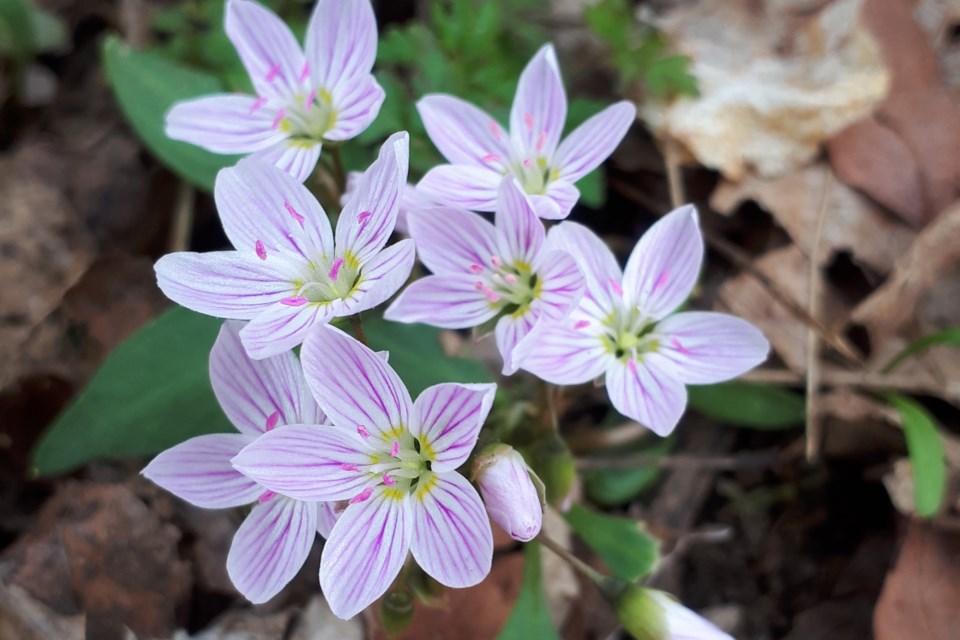“3… 2… 1… Grow!” This recent heat wave has given a real boost to the spring-time growth of the local wildflowers. There is a group of early bloomers that always have a race against time and the elements to create blossoms and attract pollinators before being shaded out of existence: the spring ephemerals.
‘Ephemeral’ means to be transitionary, fleeting or short-lived, referring to the challenge facing these plants to complete their life cycle within a few weeks of early spring before the forest trees leaf out and cast the forest floor in heavy shade.
Included in this list are: spring beauty, bloodroot, fawn lily (also called trout lily), blue cohosh, squirrel corn and, of course, the red and white trilliums. A close look at the growing conditions reveals how hardy these delicate flowers really are.
These are all perennials, meaning that the plant is long living, often with a bulb holding its energy in reserve. Despite the snow and frost above, it has continued growing all winter long; perhaps not with green leaves showing (although some plants do exhibit an ‘evergreen’ appearance).
As soon as the snow melts and the soil begins to warm, the bulb kicks into gear and sends up a shoot. This new growth is quite remarkable, as it needs to have plus five degrees to process the sunlight into sugars, and a late spring frost or snow doesn’t freeze the cells in the new leaf.
Even if the temperature falters a bit (and it often does) growth continues due to the close relationship the bulb’s rootlets have with the mycorrhizal fungi within the soil. The fungi break down the elements of the soil and transfers these essentials to the rootlets, thus providing energy for continuous growth.
Water is of great importance for any plant to grow, and the moisture held in rich woodland soils is of limited supply. “April showers bring May flowers” kind of thing. A warm dry spring can be detrimental to the successful growth of these spring ephemerals.
Nutrient availability is also dependent on soil temperature, as low temps mean slow development. But again that association with soil fungi kicks into gear and production continues.
Meanwhile, up top side, the new shoot adds to this demand for growth energy by way of photosynthesis, that almost magical process of creating life out of thin air and sunlight. This process works best at 20 degrees and full sun. Which means the trees are also preparing to pop open their leaf buds.
Then comes the tipping point for the wildflowers, as they have to supply enough energy for flower development to attract pollinators yet at the same time resupply the bulb with energy to hold fast until next spring. So the leaves, albeit a week old, are sacrificed.
No sense in maintaining the sunlight-powered leaves when the tree shade blocks the source, so remaining energy is transferred to the flowers for seed formation and the leaves wither and disappear; which is why you can’t see fawn lily or squirrel corn leaves in June, despite blanketing the forest floor in April.
Some species, like fawn lily and white trillium, take up to eight years of growth before enough energy has been amassed to produce a flower. A little respect for these plants in regards to endurance and hardiness.
Spring ephemerals are sought by all trail walkers, their blossoms truly lifting our spirits from the doldrums of a dark and cold winter season.
For the last four decades I have been recording the first day of blooming for these spring plants (and a few hundred others). The spring blooming species are the most exciting to track due to the variability of April’s weather.
Despite the record-shattering heat of the last week, spring beauty and coltsfoot are right on their average date of first bloom. In the spring of 2012 these ephemerals all popped open a good month ahead of usual, but this year are back on ‘schedule.’
As you walk the park trails or explore the wilderness areas and stumble across an early spring flower, pause to appreciate the unique challenges this plant has faced to produce that cheerful blossom.



